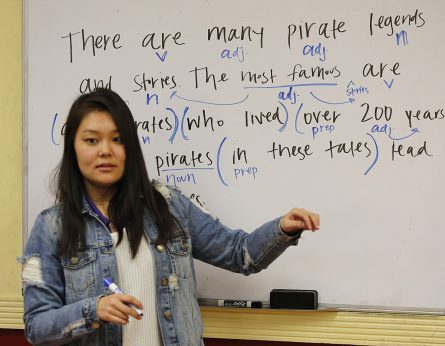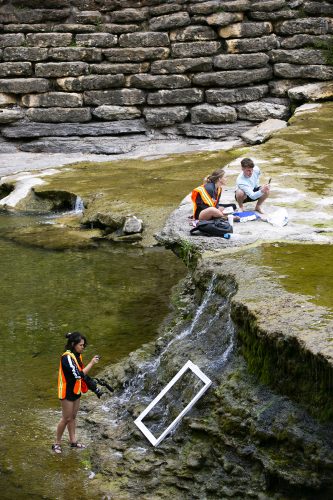Excerpts taken from TCU Magazine
A service-learning component should not just benefit a partner in the community; the schools, agencies or other nonprofits receiving the assistance also must have a voice in what the students do for them. And the service-learning experience has to support overall learning objectives, typically in students’ academic majors or minors.
“There needs to be reflection, which can be the most important piece,” said Boyd, who has led the university’s program since 2006. “Students need to have a way to integrate their service learning with their lives and other sources of learning.” Instructors and students touch base regularly throughout the course, and students often write end-of-semester papers that delve into the intellectual and emotional impact of the experience.
Boyd cites research that shows service-learning experiences help students acquire skills as varied as problem-solving, career development and the ability to understand complex issues. The community partners, meanwhile, receive meaningful contributions from the students, making this type of engagement a “win-win,” she said.
In the 2018-19 academic year, more than 500 TCU students who took courses in art therapy, criminology, sociology, environmental science, political science, nursing and dozens of other disciplines received academic credit for working for the benefit of the community.
An ‘Invaluable Experience’
Mary McKinney ’75, senior instructor in Spanish, has had her students work with more than 20 agencies around Fort Worth since 2009.
“What I read in my students’ reflection papers is that working in the field made them
less afraid of making mistakes and more  comfortable using the language,” she said.
comfortable using the language,” she said.
At the start of each semester, McKinney hosts an agency fair. “It is set up like speed dating, giving our students an opportunity to speak in small groups with each person and get a better idea of where they would like to perform their service,” she said. “Even if they weren’t matched to a school, all of my students are in some kind of teaching role.”
In the 2018-19 academic year, McKinney’s students spent three hours a week at locations including Iglesia San Miguel, Mary Louise Phillips Elementary School, International Newcomer Academy, World Languages Institute and Northside Inter-Community Agency.
McKinney said it took years for her to find just the right community partners for her students. “What we need are places where students can use their language vocally, not do things like translate brochures,” she said.
At World Languages Institute, Caroline Cajas ’19, a biology major, spent the spring before her graduation helping middle school students hone their Spanish skills as they delved into topics such as the Spanish diaspora and racism.
“Going forward in my career, I’ll most likely be working with adults, but this experience has made me want to continue volunteering with kids,” Cajas said. “Some of the students here told me until they saw me, they didn’t realize there were Hispanic students at TCU.”
“The students from Dr. McKinney’s class become role models to our students,” said Guadalupe Barreto, principal at the World Languages Institute, a secondary school in the Fort Worth Independent School District that offers a Spanish immersion track and bilingual services. “Both the TCU and the WLI students interact in Spanish, providing our students the opportunity to be role models as well.”
At Mary Louise Phillips Elementary, Emily Souder ’19, a movement science major, worked every Wednesday with four students in 30-minute one-on-one sessions. Among her pupils was a first grader whose family recently moved to North Texas from Guatemala.
“In my time here at this school, I’ve learned there is definitely a difference between adult Spanish and kid Spanish,” Souder said after helping the girl read ¡Hoy volaré!, a Mo Williams picture book featuring a pig and an elephant.
“I’ve been so surprised over the fluidity of the language, how the kids go back and forth between English and Spanish,” Souder said. “I had to learn to keep up!”
Charlee Bisch ’19, a speech-language pathology major, considers her work at International Newcomer Academy a high point of her TCU education. “We are at a university that lives its mission statement to make us better global citizens,” she said. “It was truly an invaluable experience.”
A River Runs Through it
 One of Boyd’s favorite aspects of overseeing the service-learning program is facilitating
relationships among faculty and departments. “Sometimes it’s hard for someone to think
what a service-learning component might be for something like English or history,
but there are so many possibilities.”
One of Boyd’s favorite aspects of overseeing the service-learning program is facilitating
relationships among faculty and departments. “Sometimes it’s hard for someone to think
what a service-learning component might be for something like English or history,
but there are so many possibilities.”
Boyd is gratified when her office supports interdisciplinary projects such as Restorying the Trinity River, which brings together courses in anthropology, art and geography to examine ways to increase community engagement with the river that runs through Fort Worth. The project started in the spring semester and will continue through the 2019-20 academic year.
“The problem behind the project is that people often feel disconnected from the natural world,” said Dave Aftandilian, associate professor of anthropology. “Because there are no big problems in the world that we can solve from just one discipline’s perspective, this became an interdisciplinary project.”
Aftandilian, who directs the human-animal relationships minor,reached out to the Trinity River Vision Authority and the Tarrant Regional Water District, which supplies water to more than 2 million people in Fort Worth, Arlington and Mansfield, Texas.
“Among [the regional water district’s] top goals are getting people to use the Trinity more for recreation, and we thought we might be able to help,” Aftandilian said.
Two studio art professors embraced the project’s main concept and added their courses to the effort.
In April, Adam Fung, associate professor of art, took his studio art class out to paint en plein air at Airfield Falls Conservation Park, the site of the only natural waterfall near Fort Worth. Some of the students’ artwork will be printed on vinyl wraps.
The regional water district plans to use those wraps to help beautify siphons and junction boxes throughout the trail. “We also hope future students might come out and paint directly on structures like pump stations, which are concrete and metal and not very aesthetically pleasing,” said Tina Nikolic, neighborhood and recreation enhancement coordinator for the Tarrant Regional Water District.
At the waterfall, Nick Bontrager, associate professor of new media art, had his students use a piece of high-tech equipment on loan from the university’s Department of Geological Sciences to laser-scan the waterfall to within a millimeter of accuracy. Other undergraduates recorded the sounds of the river and the falls or shot video above and below the water.
“We used the pictures and sound recordings to chart the progression of the pollution,” said Ellie Nosich ’19, a communication studies major. She created a mixed-media presentation for the project. “We think of pollution in the Trinity as a call to action.”
All of the data the students collected, along with many of the projects, were offered to the regional water district for study and use. The district even allowed access to environmental studies that helped the team determine expedition sites, Bontrager said. “They have been extremely supportive of our work.”
Carol Thompson, professor of sociology, appreciates how the river project represents an expanding vision of service learning. “If you think about the most narrow version of service learning, it’s going out to an agency or community and helping them, and our students did that.
“But when you are talking about global problems or environmental degradation and talking about service to humanity and nature, it can be harder to pin down what that looks like,” Thompson said. “Restorying the Trinity is engaging the community in a broader way.”
Thompson took several students to the river on a Saturday to tag turtles for what she describes as an ongoing service project for both the academic community and the community at large.
Thompson’s group worked with Andrew Brinker ’06 MS, a science teacher at R.L. Paschal High School in Fort Worth. He organized the Trinity River Turtle Study, a multiyear conservation project that received support from the College of Education.
For two years, TCU students have assisted with the turtle project both as volunteers and in the context of service learning, said Brinker, who was a biology graduate student at the university.
During that time, 700 turtles have been marked by community volunteers and TCU’s service-learning students. More than 150 marked turtles were later recaptured. Brinker shares the turtle census data with the biologists at the Texas Parks and Wildlife Department.
Students helped Brinker trap turtles, scan them for microchips and add chips to turtles that did not have them. Before releasing the turtles back into the river, the team measured and marked the animals for further study.
“No one wants to think of life in Fort Worth without a thriving river,” Thompson said. Through the Restorying the Trinity River project, “our students are bringing their talents to the challenges and problems that surround the Trinity and our community.”